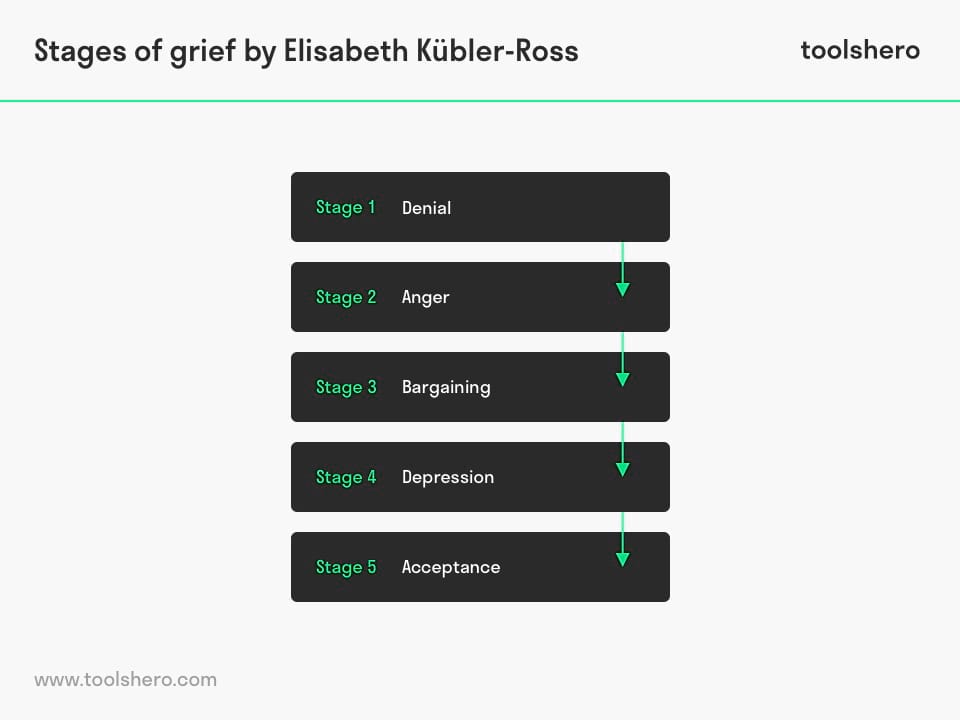5 Stages of Grief by Elisabeth Kübler-Ross

5 Stages of Grief: this article explains the 5 Stages of Grief developed by Elisabeth Kübler-Ross, in a practical way. After reading you will understand the basics of this psychological and change management tool. Other highlights include: the 5 stages of grief in order and how a non-directive approach can help someone grieve. Finally, some criticism on the model is discussed. Enjoy reading!
What are the 5 Stages of Grief?
How does someone cope with a traumatic and distressing experience? How are people learning to live with the loss of a close friend? To answer this question, the Swiss psychiatrist Elisabeth Kübler-Ross developed a 5 Stages of Grief model that shows how people deal with traumatic or distressing experiences at work or in private life, i.e. the death of a loved one.
Elisabeth Kübler-Ross discovered that terminally ill people experience a number of stages during the progress of their disease.
Her model provides an insight into how people cope with drastic changes or loss and experience the stages. As such a process is also called coping with bereavement, these five Stages of Grief is also known as the Elisabeth Kübler-Ross bereavement cycle or simply the Kübler-Ross model. She published the model in her book On Death and Dying.
The stages of grief are: denial anger bargaining depression and acceptance.

Figure 1 – The 5 stages of grief in order
What are the 5 stages of grief in order?
Despite the fact that people grieve in a personal manner, Elisabeth Kübler-Ross ascertained that a fixed pattern could be established.
In her contacts with terminally ill patients, she discovered that everybody goes through more or less the same stages of grief. This is why this theory can be applied to traumatic experiences such as the loss of a loved one, major setbacks or disappointments and dismissals.
Initially the person will be shocked after having heard the bad news. After this shock, the first stage will soon present itself:
Stage 1: Denial
Initially, people are shocked when they receive bad news. This general defence mechanism buffers the initial shock (overwhelming emotions) and gives the person the chance to come to their senses. This is known as the denial stage.
Subsequently, they will gradually recover from this shock. It is important that they can express their feelings for example by talking to a confidential counsellor.
At the end of this stage, the person will start searching for facts, the truth of for someone to blame.
Stage 2: Anger
When someone can no longer deny what is happening, feelings of anger, irritation, jealously and resentment arise. Anger and powerlessness are especially directed at their environment.
People who are feeling angry may put the blame on other people, colleagues, employees and counsellors. Sometimes the anger is directed at the bearer of the bad news.
Stage 3: Bargaining
At this stage, people are trying to get away from the dreadful truth in many different ways. This stage of the Stages of Grief and Loss involves bargaining. By setting themselves goals, the blow of bad news is softened.
In a work environment they will find it very difficult to negotiate working agreements or make promises. If they are threatened with (impending) dismissal, they will go to court as a form of counter attack.
Stage 4: Depression
During the fourth stage, the truth is finally sinking and the person involved feels helpless and misunderstood.
As a result, they will be withdrawn and avoid communications. They do not answer the phone or respond to e-mails. There is a chance that they could take refuge in alcohol and drugs such as painkillers, tranquillizers and sleep-inducing drugs.
Stage 5: Acceptance
When the person involved becomes aware of the fact that there is no more hope, they can accept the bad news and accept the loss.
They can recover from the previous stages and accept their grief. After some time they will feel like taking up activities again and they will start making plans again.
Non-directive
Elisabeth Kübler-Ross ’s Stages of Grief theory was primarily used for coping with grief but is still used today for understanding change reaction in large organizational changes.
The ultimate goal is acceptance, in which a non-directive attitude (supportive) plays an important role. In addition, the main conditions are being empathetic towards the person in question and accepting them unconditionally with pure authenticity.
By listening to someone’s story, the other party will act as a sounding board. People will go through the above mentioned stages at different paces. Some people will get stuck in a certain stage, whereas other people go through several Stages of Grief simultaneously or in a different order. Some Stages of Grief may overlap one another or people may skip a number of stages altogether.
Criticism on the 5 Stages of Grief
Despite the fact that the grief model is widely adopted and used, for example by mental health professionals and support groups, there is also criticisms. The criticisms mostly include the lack of empirical evidence supporting the 5 phases as described by Kubler-Ross.
In addition, critics mention that the model is a product of a particular time and culture. It may not apply to the way people in other cultures are coping with loss. Friends and family of deceased people from certain Indonesian tribes handle bereavement very differently than a Westerner, and show very different responses to loss. These points have been made several times over the years, by different researchers.
Other criticisms include:
- The evidence of the different stages has not been demonstrated
- There is no evidence that people go from stage 1 to a later stage
- Factors such as environment and context are not taken into account. These can make a significant difference
Misapplication of the model can be detrimental to a person’s mental state. It can lead to people being under the impression that they are not dealing with loss ‘correctly’. The phases are written descriptively, but are more often seen as prescriptive.
It’s Your Turn
What do you think? Do you recognize the stages of grief and the practical explanation or do you have more suggestions? What are your tips when it comes to the 5 Stages of Grief and Loss model? How do you deal with loss and what are the tips that you can share to help others?
Share your experience and knowledge in the comments box below.
More information
- Barone, J. E., & Ivy, M. E. (2004). Resident work hours: the five stages of grief. Academic Medicine, 79(5), 379-380.
- Kübler-Ross, E. & Kessler, D. (2014). On grief and grieving: Finding the meaning of grief through the five stages of loss. Simon and Schuster.
- Kübler-Ross, E. (1970). The care of the dying-whose job is it?. The International Journal of Psychiatry in Medicine, 1(2), 103-107.
How to cite this article:
Mulder, P. (2014). 5 Stages of Grief (Kübler-Ross). Retrieved [insert date] from Toolshero: https://www.toolshero.com/change-management/5-stages-of-grief/
Original publication date: 08/14/2014 | Last update: 03/08/2024
Add a link to this page on your website:
<a href=”https://www.toolshero.com/change-management/5-stages-of-grief/”> Toolshero: 5 Stages of Grief (Kübler-Ross)</a>













5 responses to “5 Stages of Grief by Elisabeth Kübler-Ross”
This is great, except that this was based on her work with the dying. Yes, the living go through much of the same, but there are the life-long aspects to grief that her work never covered.
To the writer:
Please define non-directive. Also, I know u meant to say that we must feel empathetic toward those grieving, not “emphatic”
Thank you for your feedback, Jim. We’ve updated the article and hopefully clarifies your question.
Yes thanks. My husband had a horrible accident. After 2 1/2 years I found her old paperback book. This is for the living also Primary caregivers
Everybody experiences grief differently, however, the 5 stages you’ve explained really well in your article are the common emotions which individuals go through at different rates. Carrying out simple lifestyle changes are a great way to help get through the grieving process such as exercising, seeing a counsellor and investing in some memorial jewellery so you know that your loved one will be with you at all times.